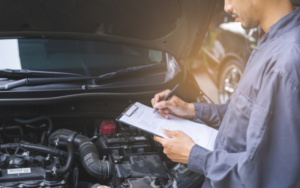Keeping up to date with routine MOTs is a key part of car ownership and can help to prolong the lifespan of your vehicle. Not only are MOTs a great way to stay on top of your car’s safety and general condition, they’re also a legal requirement. A car MOT is a safety check performed by a trained mechanic at a designated MOT centre or garage to ensure your car or van meets road safety standards.
Every vehicle in the UK needs an MOT test each year, once it is more than 3 years old.
Failing an MOT test can be gutting, especially if the repairs are going to be expensive. But our top tips for preparing your car for an MOT can be considered to increase the likelihood of passing your next MOT!
How to prepare your car for its next MOT!
Our guide to car servicing and MOTs highlights all things MOTs and why they’re important. First though, get ahead of the game and consider the top tips below on how to prepare for an MOT.
1. Clean your car.
Your car won’t fail its MOT if it’s dirty, but it’s always a good idea to give it a good clean before you get an MOT. A clean car not only gives a good first impression to the examiner, but it can also help with the inspection. When cleaning your car, remember to do both the interior and exterior and ensure that both number plates are clean and visible. Having a dirty license plate is actually illegal in the UK, and you could face a fine of up to £1,000!
Read our top tips on how to clean your car like a pro!
2. Check your windscreen & wipers.
Cracks and chips in your windscreen are common, and they can be unexpected. Prepare for an MOT by checking over your windscreen for any cracks, dents and splits. For a small cost, it can be worth repairing a crack or chip before your MOT to ensure it does not fail. Any defects in your windscreen should be repaired asap as they can turn into larger issues.
While you’re there, you should also check over your windscreen wipers and ensure they are in good condition. You can fail your MOT if your wipers don’t effectively clear the windscreen. One of the most commonly Google’d car questions is “How to change windscreen wipers?” so you’re not alone if you don’t know how to! The easiest way to check your wipers is by operating the windscreen washer and wipers and checking to see if the windscreen is clear and streak free. If not, your wipes could need replacing and your washer fluid could need topping up.
3. Ensure all lights are working.
Did you know headlights are the number one MOT fail? Faulty or broken lights are dangerous as they affect your visibility whilst driving and fail an MOT test. Check all interior and exterior lights are in good working order. If not, you may need to change your bulbs before the MOT test. Remember to check all lights on your car, headlights, brake lights, fog lights, taillights, indicators, hazard lights, reversing lights, and interior lights.
Turn on the ignition and test each light one at a time. To check lights such as brake lights and indicators you may need some assistance, or you can use a wall or reflective surface to check they’re operating correctly.
4. Inspect the tyres.
When it comes to checking your tyres in preparation for an MOT, there are a few things to consider. Firstly, check the overall condition of the tyre. There should be no obvious damage such as lumps, cracks, lumps, or bulges. Then ensure your tyre tread depth is within the legal limit. Basic car maintenance, like knowing how to check your tyre tread depth, is something all drivers should be able to perform. You can do this easily by using a 20p coin. Put the coin in the ridge of your tyre, and if you can see below the lining of the 20p, your tyres are too thin.
You should also ensure your tyres are provably inflated. Most modern cars will display a dashboard warning if your cars tyres are under or over inflated but you can also check with a tyre pressure monitor. If they need inflating or deflating, you can do this at home or at many local garages or supermarkets for a a small fee.
5. Top up engine oil.
Not only can topping up your engine’s oil help to get you through your next MOT, but it can also save fuel and prolong the lifespan of your car. Many modern cars come with an engine oil dashboard warning light, but if you want to check it yourself, it’s pretty easy to do so. Head under the bonnet, then locate the car’s dipstick. Take it out, wipe it clean and then put it back in. Take it out again and read the dipstick. It will show the min and max levels of engine oil and where your current levels are. If the oil is between the minimum and halfway, we recommend topping up your engine oil.
6. Check your brakes.
Your brakes are an essential part of your car, and faulty brakes can be life-threatening! There are some common tell-tale signs that your brakes have issues:
- Brake warning light on the dashboard.
- Grinding, squealing or squeaking noises.
- Brake pedal feels spongy or soft.
- It takes you longer stop stop than normal.
- Car pulls to one side.
- A burning smell.
- The steering wheel vibrates.
Brakes aren’t really something you can fix at home, so we recommend contacting a trained mechanic or local garage to take a closer look.
7. Test your suspension.
Your car’s suspension is responsible for smoothing bumps in the road and providing traction. It’s easy to test your suspension at home by performing a simple ‘bounce test’. Push down on each corner of the vehicle and take note of how many times it bounces back up. In theory, it should bounce straight back up, and if it bounces 2-3 times, it can indicate an issue with your suspension.
8. Check the exhaust.
And finally, before you book in for that annual MOT, make sure you check your exhaust is in good working order. Checking your exhaust is easy, and you just need to know what to look out for. Ensure there are no signs of rust, corrosion, leakage, or damage. Also listen out for rattling noises or excessive noise (more than usual) when the engine is running. If you have any concerns about your exhaust, you can have it examined by a mechanic before your MOT.
Related Content:

Bought a faulty car – what can I do?
Find out your consumer rights when you’ve bought a used car which turns out to be faulty.

Most common car faults!
Get ahead of the game and learn how to fix these most common car faults.

How often should you service your car?
The general rule is to have a service every year or every 12,000 miles, whichever comes first.

